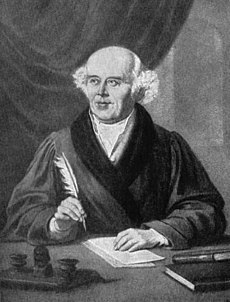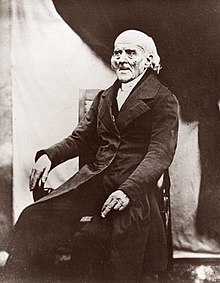హానిమాన్
| శామ్యూల్ హానిమాన్ | |
|---|---|
 శామ్యూల్ హానిమాన్ | |
| జననం | 1755 ఏప్రిల్ 10 Meissen, Electorate of Saxony |
| మరణం | 1843 జూలై 2 (వయసు 88) ప్యారిస్, ఫ్రాన్స్ |
| జాతీయత | జర్మనీ |
| రంగములు | హోమియోపతీ |

'క్రిస్టియన్ ఫ్రెడ్రిక్ శామ్యూల్ హానిమాణ్ (German: [ˈhaːnəman];ఏప్రిల్ 10 1755[1] - జూలై 2 1843) జర్మనీకి చెందిన వైద్యుడు. వైద్యచరిత్రలో ప్రత్యామ్నాయ వైద్యమైన హోమియో విధానాన్ని ప్రపంచానికి పరిచయం చేశాడు.[2][3]
ప్రారంభ జీవితం
[మార్చు]క్రిస్టియన్ ఫ్రెడ్రిక్ శామ్యూల్ హానిమన్ డ్రెస్డెన్ కు దగ్గర లో గల సక్సోనీ నందలి మీస్సెన్ లో జన్మించాడు. ఈతని తండ్రి క్రిస్టియన్ గోట్టిఫ్రెడ్ హానిమాన్[4] పైంటర్, డిజైనర్ గా పనిచేసి మీస్సెల్ లో ప్రముఖ వ్యక్తిగా నిలిచారు.[5] హానిమన్ తండ్రి పింగాణి పాత్రలపై రంగులు వేసేవాడు. 10 మంది సంతానంలో హానిమన్ అగ్రజుడు. కాగా హానిమన్ పుట్టినప్పటి నుండి జీవితమంతా పోరాటంలా సాగింది. బాల్యంలో హానిమాన్ అనేక భాషలలో నిష్ణాతుడు. ఈయనకు ఆంగ్లము, ఫ్రెంచ్, ఇటాలియన్, గ్రీకు, లాటిన్ భాషలు తెలుసు. ఈయన చివరకు ఒక అనువాదకుడిగా, భాషా ఉపాధ్యాయుడుగా "అరబిక్,సైరియాక్,చాల్డాయిక్, హిబ్రూ" లకు ఉన్నారు.[6] హానిమాన్ లీప్జిగ్ లో రెండు సంవత్సరాలు వైద్యవిద్యనభ్యసించారు. లీప్జిగ్ లో వైద్య సదుపాయములు లేనందువల్ల ఆయన వియన్నాకు వెళ్లారు. అచట పది నెలలు చదివారు.[7] ఆ తర్వాత ఆయన ఆగష్టు 10 1779 లో ఎర్లాంగెన్ విశ్వవిద్యాలయంలో ఎం.డి గ్రాడ్యుయేషన్ చేశారు.అచట అనేక గౌరవాలు పొందారు. ఆయన పేదరికం ఆయనకు తక్కువ ఫీజులు వసూలు చేసిన ఎర్లాంగన్ పాఠశాలలో చేరమని ఒత్తిడి చేసింది.[8] ఆయన పరిశోధనా వ్యాసం Conspectus adfectuum spasmodicorum aetiologicus et therapeuticus.(తిమ్మిరి కారణాలు, చికిత్స కు సంబంధించినది)[9]చిన్నతనంలో దుర్భరమైన పేదరికం, పెద్దైన తర్వాత జీవితాంతం ప్రతికూల వర్గాలతో పోరాటం. కాగా చిన్నతనం నుండే పట్టుదల, ఓర్పు, శారీరక దృఢత్వం కలిగిన హానిమన్ అన్ని ఇబ్బందులను ధైర్యంతో ఎదురొడ్డి గెలిచి ప్రజా హృదయాల్లో శాశ్వతంగా నిలచాడు. పేదరికం కారణంగా హానిమన్కు తన తండ్రి నుండి ఎలాంటి ఆర్థిక సహకారం లభించలేదు. హానిమన్ బాల్యంలో పేదరికం వల్ల ఫీజులు చెల్లించలేక స్కూలు మానేయడంతో ఆయన పట్టుదల , అసాధారణ ప్రతిభాపాటవాలను గుర్తించిన ఉపాధ్యాయులు ఎటువంటి ఫీజులు లేకుండానే విద్యాబోధన చేసేందుకు ముందుకు వచ్చారు. హానిమన్ తన 12 వ ఏటనే తోటి విద్యార్థులకు గ్రీకు భాష బోధించడం ద్వారా వచ్చే డబ్బుతో చదువు కొనసాగించాడు.[10]
మెడికల్ ప్రాక్టీసు
[మార్చు]1781 లో సక్సోనీ లోని మాన్స్ఫెల్డ్ నందలి రాగి గనుల తవ్వకాల ప్రాంతంలో గ్రామ వైద్యునిగా ఉన్నారు.[11] ఆయన "జొహన్నా హెన్రియెట్ కుచ్లర్" కు వివాహమాడి పదకొండు పిల్లలకు తండ్రి అయ్యాడు.[6] మెడికల్ ప్రాక్టీసు వదిలిన తదుపరి ఆయన వైజ్ఞానిక, వైద్య పాఠ్యపుస్తకాలకు అనువాదకునిగా పనిచేశారు.,[12] హానిమన్ సక్సోనీ చుట్టూ అనేక సంవత్సరాలు ప్రయాణించాడు. అనేక వివిధ పట్టణాలు, గ్రామాలలో నివాసమున్నాడు. ఆయన ఎల్బె నదికి దూరంగా ఎన్నడూ నివాసముండలేదు. ఆయన జూన్ 1835 న పారిస్ నగరానికి వచ్చే ముందు[13] వివిధ కాలాలలొ డ్రెస్డెన్, టోర్గా,లీప్జిగ్, కోథెన్ లలో నివాసమున్నారు.[14]
హోమియోపతీ విధానం సృష్టి
[మార్చు]హానిమన్ చిన్నవయస్సులోనే డెస్టెన్ వైద్యశాలలో ప్రధాన శస్త్రచికిత్సాధికారిగా నియమించబడ్డారు. ఆయన వైద్యంలో ఉపయోగించే అనేక రకాల పదార్థాల రసాయన ధర్మాలపై పరిశోధనలు కొనసాగించారు. ఆ కాలంలో అల్లోపతి వైద్యవిధానంలో అనాగరిక పద్ధతులను ఉపయోగించడాన్ని హానిమన్ తీవ్రంగా వ్యతిరేకించారు. వైద్యం సున్నితంగా, నిరపాయకరంగా ఉండాలని, వ్యాధులను సమూలంగా, శాశ్వతంగా నివారించగలిగేలా ఉండాలని ఆకాంక్షించారు. మెటీరియా మెడికా అనే గ్రంథాన్ని అనువదిస్తూ మలేరియా జ్వర చికిత్సకు సింకోనా అనే చెట్టు బెరడు పనిచేసేతీరును విభేదించారు. దాని ధర్మాలను తెలుసుకునేందుకోసం ప్రతి రోజు ఆ కషాయాన్ని సేవించగా నాలుగు రోజుల్లో మలేరియా జ్వరం వచ్చింది. ఈ ప్రయోగాన్ని ఆపగానే జ్వరం తగ్గింది. ఈ ఫలితాన్ని బట్టి వ్యాధులను నయం చేసే మందులకు వ్యాధులను కలిగించే శక్తి ఉందా అన్న అనుమానం డాక్టర్ హానిమన్కు కలిగింది. ప్రకృతిలోని ఏ పదార్థమైనా ఆరోగ్యవంతుడైన మనిషిలో ఎలాంటి వ్యాధి లక్షణాలను కలిగిస్తుందో అలాంటి లక్షణాలను కల్గిన వ్యాధిని అదే పదార్థం యొక్క సూక్ష్మ మోతాదులతో తొలగించవచ్చని నిర్ధారించుకున్నారు. ఇదే సారూప్య ఔషధ సిద్ధాంతం. ఆ తర్వాత కాలంలో అనేక ఔషధ పదార్థాలను తనపై స్వయంగా పరీక్షించుకున్నారు. భవిష్య మానవాళి ప్రయోజనాల కోసం తన ప్రాణాలను సైతం పణంగా పెట్టిన మహామనీషి డాక్టర్ హానిమన్ అనడంలో ఎలాంటి అతిశయోక్తిలేదు. మందులను మూల పదార్థాలతో వాడితే అవి అవయవాల స్థాయిలో పనిచేస్తాయే తప్ప జీవశక్తిని ప్రభావితం చేయలేవని పేర్కొంటూ మందులను సూక్ష్మీకరించడం ద్వారా జీవశక్తిని ప్రభావితం చేసేలా చేయాలని అభిప్రాయపడ్డారు. ఏ వ్యాధికైనా ఆ లక్షణాలకు సారూప్యమైన ఏకైక ఔషధాన్ని సూక్ష్మరూపంలో ప్రయోగించడం ద్వారా వ్యాధులను శాశ్వతంగా, సమూలంగా నివారించవచ్చని హోమియో ముఖ్య సూత్రాలు. కాగా రోగి తెలియజేసే సమస్త శారీరక, మానసిక వేదనలను అనుసరించి సారూప్యమైన మందులను రోగికి ఇవ్వడం ద్వారా సంపూర్ణ ఆరోగ్యాన్ని కలిగించవచ్చని డాక్టర్ హానిమన్ నిరూపించాడు. ఈ సూత్రాలన్నింటినీ వివరిస్తూ 1810 లో తన 42 వ ఏట ఆర్గనాస్ ఆఫ్ రేషనల్ హీలింగ్ అనే గ్రంథాన్ని రచించారు. కాగా 1811 నుండి డాక్టర్ హానిమన్ లీప్జిగ్ విశ్వవిద్యాలయంలో అధ్యాపకుడుగా పనిచేశారు. ఆయన బోధనలకు ప్రభావితమై అనేక మంది వైద్యులు శిష్యులుగా చేరారు. వారి సహకారాలతో అనేక మందులపై నిర్విరామంగా, నిరంతరంగా ప్రయోగాలు జరిపి, వాటి ఫలితాలను వివరిస్తూ 1821 లో మెటీరియా మెడికా ప్యూరా అనే గ్రంథాన్ని 6 సంపుటాల్లో రచించారు. ఈ విప్లవాత్మకమైన నూతన ఆవిష్కరణలతో ఒకే మందును సూక్ష్మమోతాదులో ఇవ్వడం ద్వారా వ్యాధి శాశ్వతంగా నివారణ కావడంతో ఆనాటి అల్లోపతి మందుల దుకాణాలు మూతపడ్డాయి.
ఈ క్రమంలో కొన్ని చిక్కులు ఏర్పడడంతో డాక్టర్ హానిమన్ 1821లో లీప్జింగ్ వదిలి కొథేన్ అనే చిన్న గ్రామానికి మారడం జరిగింది. అక్కడ కూడా శిష్యుల సహకారంతో పరిశోధనలు కొనసాగించారు. సరైన ఔషధాలను ఎంపిక చేసి ఇచ్చినప్పటికీ కొన్ని వ్యాధులు తాత్కాలికంగా ఉపశమించి మళ్లిd, మళ్లి తిరగబెడుతున్నట్లు గమనించారు. ఈ దిశగా సుమారు 12 సంవత్సరాలు పాటు పరిశోధించి 1828 లో క్రానిక్ డిసీజస్ అనే గ్రంథాన్ని రాశారు.[2]
వ్యక్తిగత జీవితం
[మార్చు]డాక్టర్ హానిమన్ 75 సంవత్సరాల వయస్సులో భార్య మరణించింది. అప్పటికి ఇద్దరు కుమారులు, తొమ్మిది మంది కుమార్తెలు సంతానం. కాగా 1835 లో 36 సంవత్సరాల వయస్సు గల సంపన్న కుటుంబానికి చెందిన మెలనిడేడి హెర్వల్లిd అనే ఫ్రాన్స్ మహిళను డాక్టర్ హానిమన్ వివాహం చేసుకొని జర్మనీ వదిలిపెట్టి పారిస్ చేరుకున్నారు. అక్కడ 8 సంవత్సరాల పాటు వైద్య సేవలు అందించిన డాక్టర్ హానిమన్ తన 88 వ ఏట 1843 జులై 2 వ తేదీన తుదిశ్వాస వదిలారు. అమూల్యమైన హోమియో వైద్య విధానాన్ని భవిష్యత్ తరాలకు అందించడం కోసం తమ శరీరాలనే ప్రయోగశాలలుగా చేసుకొని మందులను తమపైనే ప్రయోగించుకొని రుజువుపరచి, గ్రంథస్తం చేసి డాక్టర్ హానిమన్, ఆయన శిష్యులను మానవజాతి ఎన్నటికీ మరువదు.
రచనలు
[మార్చు]Hahnemann wrote a number of books, essays, and letters on the homeopathic method, chemistry, and general medicine:
- Heilkunde der Erfahrung. Norderstedt 2010, ISBN 3-8423-1326-8
- Versuch über ein neues Prinzip zur Auffindung der Heilkräfte der Arzneisubstanzen, nebst einigen Blicken auf die bisherigen [Essay on a New Principle for Ascertaining the Curative Powers of Drugs] (in German). 1796. Archived from the original on 2014-04-25. Retrieved 2014-04-12.
{{cite book}}: CS1 maint: unrecognized language (link) reprinted in Versuch über ein neues Prinzip zur Auffindung der Heilkräfte der Arzneisubstanzen, nebst einigen Blicken auf die bisherigen. Haug. 1988. ISBN 3-7760-1060-6. - Fragmenta de viribus medicamentorum positivis, a collection of 27 drug "provings" published in Latin in 1805.[15][16][17]
- The Organon of the Healing Art (1810), a detailed delineation of what he saw as the rationale underpinning homeopathic medicine, and guidelines for practice. Hahnemann published the 5th edition in 1833; a revised draft of this (1842) was discovered after Hahnemann's death and finally published as the 6th edition in 1921.[18][19]
- Materia Medica Pura, a compilation of "homoeopathic proving" reports, published in six volumes between vol. I in 1811 and vol. VI in 1827. Revised editions of volumes I and II were published in 1830 and 1833, respectively.[20]
- Chronic Diseases (1828), an explanation of the root and cure of chronic disease according to the theory of miasms, together with a compilation of "homoeopathic proving" reports, published in five volumes during the 1830s.
- Lesser Writings of Samuel Hahnemann. Archived from the original on 2011-12-07. Retrieved 2014-04-12., which were gathered by Dudgeon.
- The Friend of Health, in which Hahnemann "recommended the use of fresh air, bed rest, proper diet, sunshine, public hygiene and numerous other beneficial measures at a time when many other physicians considered them of no value."[21][22]
- Appeal to Thinking Philanthropist Respecting the Mode of Propagation of the Asiatic Choler, in which Hahnemann describes cholera physicians and nurses as the "certain and frequent propagators" of cholera and that whilst deriding nurses' "fumigations with chlorine", promoted the use of "drops of camphorated spirit" as a cure for the disease.[23]
- Hahnemann also campaigned for the humane treatment of the insane in 1792[24]
- John Henry Clarke wrote that "In 1787, Hahnemann discovered the best test for arsenic and other poisons in wine, having pointed out the unreliable nature of the "Wurtemberg test, " which had been in use up to that date." [25][26]
- Samuel Hahnemanns Apothekerlexikon . Vol.2 . Crusius, Leipzig 1798-1799 Digital edition[permanent dead link] by the University and State Library Düsseldorf
- Reine Arzneimittellehre . Arnold, Dresden (several editions) 1822-1827 Digital edition[permanent dead link] by the University and State Library Düsseldorf
- Systematische Darstellung der reinen Arzneiwirkungen aller bisher geprüften Mittel . Vieweg, Braunschweig 1831 – Digital edition[permanent dead link] by the University and State Library Düsseldorf
మూలాలు
[మార్చు]- ↑ Though some sources do state that he was born in the early hours of 11 April 1755, Haehl, Richard (1922). Samuel Hahnemann his Life and Works. Vol. 1. p. 9.
Hahnemann, was born on 10 April at approximately twelve o'clock midnight.
- ↑ 2.0 2.1 ప్రజాశక్తి, కర్నూలు (9 April 2017). "హోమియో వైద్య పితామహుడు డాక్టర్ సి.ఎప్.ఎస్ హౌనెమన్". Archived from the original on 11 April 2019. Retrieved 11 April 2019.
- ↑ ఆంధ్రభూమి, ఇతర వార్తలు (9 April 2018). "హోమియో వైద్య విధానానికి ఆద్యుడు". జనార్దన నుగ్గు. Archived from the original on 11 April 2019. Retrieved 11 April 2019.
- ↑ Homoeoscan|Homoeopathy [1] Archived 2014-04-13 at the Wayback Machine Brief History of Life of Samuel Hahnemann, The Father of Homoeopathy.
- ↑ Harris Livermore Coulter (1977). Divided Legacy, a History of the Schism in Medical Thought. Vol. II. Washington: Wehawken Books. p. 306. ISBN 0-916386-02-3. OCLC 67493911.
- ↑ 6.0 6.1 "Hahnemann Biography". Archived from the original on 2013-10-15. Retrieved 2009-01-13.
- ↑ Martin Kaufman (1972). Homeopathy in America, the Rise and Fall of a Medical Heresy. Baltimore: Johns Hopkins University Press. p. 24. ISBN 0-8018-1238-0. OCLC 264319.
- ↑ Haehl, vol. 1, p. 24.
- ↑ Cook, p. 36.
- ↑ Richard Haehl (1922). Samuel Hahnemann His Life and Work. Vol. 2. London: Homoeopathic Publishing. p. 11. OCLC 14558215.
- ↑ Haehl, vol. 1, p. 26.
- ↑ Bradford, pp. 515–16.
- ↑ Cook, p. 168.
- ↑ Cook, pp. 83–4,
- ↑
Fragmenta de viribus medicamentorum positivis, sive in sano corpore humano observatis (in Latin). 1824. OCLC 14852975.
{{cite book}}: CS1 maint: unrecognized language (link) - ↑ Übersetzung der 'Fragmenta de viribus medicamentorum' von Marion Wettemann (PDF) (in German). Archived from the original (PDF) on 2008-04-13. Retrieved 2014-04-12.
{{cite book}}: CS1 maint: unrecognized language (link)[dubious ] - ↑ ''Fragmenta de viribus'' and ''Materia Medica Pura'' full-text in French Archived 2014-04-17 at the Wayback Machine. Homeoint.org. Retrieved on 2012-05-16.
- ↑ Online etext of Hahnemann's Organon der Heilkunst.
- ↑ Organon of Homeopathy, 6th version Archived 2007-04-29 at the Wayback Machine English version, full text online; German original (other format); English translation Archived 2014-07-13 at the Wayback Machine. Homeopathyhome.com. Retrieved on 2012-05-16.
- ↑ Hahnemann's Materia Medica Pura full-text in English Archived 2008-05-17 at the Wayback Machine. hpathy.com. Retrieved on 2012-05-16.
- ↑ Rothstein, William G. (1992). American physicians in the nineteenth century: from sects to science. Baltimore: Johns Hopkins University Press. p. 158. ISBN 978-0-8018-4427-0.
- ↑ Samuel Hahnemann (1792). The Friend of Health.
- ↑
Samuel Hahnemann (1831). Appeal to thinking philanthropist respecting the mode of propagation of the Asiatic choler. pp. 753–763. OCLC 3440881.
{{cite book}}:|work=ignored (help) - ↑
Samuel Hahnemann (1796). Description of Klockenbring During his Insanity. pp. 243–249. OCLC 3440881.
{{cite book}}:|work=ignored (help) - ↑ John Henry Clarke (1894). Homoeopathy: all about it; or, The principle of cure. London: Homoeopathic Publishing. OCLC 29160937.
- ↑ Haehl, Vol. 1, p. 34.
